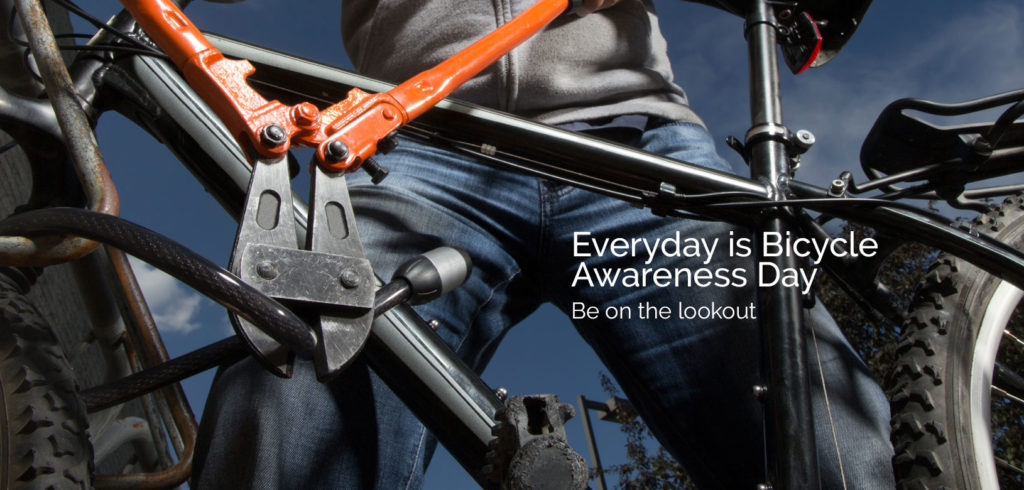
Bike Theft Prevention and Stolen Bicycle Recovery
Bicycle theft is a huge problem across the United States but with a few simple precautions from Boomerang you can successfully decrease the chance of someone making off with your property.
- Step 1: Register Your Bike
- Step 2: Use a Quality Lock
- Step 3: Know Where and How to Lock
- Step 4: Use a Boomerang CycloTrac
- Step 5: Your Bike Was Stolen Anyway
Step 1: Register Your Bike and take photos
The first step in any anti-theft strategy is to register your bike’s serial number at the National Bike Registry.
https://www.nationalbikeregistry.com/register.html
If you prefer, you can register by phone (800-848-BIKE)
Information from NBR Website “Many stolen bikes are recovered by police but there is no way to identify the owner. With the NBR service, you can register your bicycle by serial number in our national database and apply the special label you receive to your bike. If your bike is ever stolen, it can be identified and you can prove ownership. Law Enforcement anywhere can access our database, advise us that your bike has been recovered, and you can be notified immediately.”
After you have registered your bike take a few photos of your bike and save them with your serial number and registration information.
Step 2: Use a Quality Lock
Heavy-duty U-locks and jacketed hardened chain locks designed for bicycles are ideal. In addition, Boomerang recommends a second U-lock, chain, or cable to secure both wheels and the frame to something solid. Inexpensive locks are very easy to cut. The more you spend on a lock the longer it will take for the thief to cut it.
We also recommend keeping your lock clean and working efficiently by following the manufactures recommendations.
Step 3: Know where and how to lock your bike safely
Of the 53 stolen bicycle reports BART (Bay Area Rapid Transit Police Department) received in May 2014, 19% of them were locked up overnight outside. In all situations, its best to not leave your bike outside overnight. The rest of the time remember to:
- Always try to use a bike rack. If a rack is not available >
- Lock your bike to a solid, metal non-movable object (avoid a tree or wooden railing)
- Shake the bike rack or non-movable object to ensure that it’s tight and secure to the ground.
- Always make sure you secure the frame when using a lock. Just putting the lock around the wheel doesn’t provide nearly as much protection.
- Remove the front wheel, then lock both wheels together along with the frame to the rack.
- After you lock it make sure thieves can’t simply lift the bike over the rack or object
- Park in a visible spot where there are lots of people around all of the time.
- Customize your bike by adding color or stickers for easy identification.
- Park your bike near nicer bikes to make your bike less of a target.
- Don’t park or lock your bike in the same location every day.
Although there are many locking strategies, every lock at the very least should secure the frame and rear wheel directly to the rack. It’s important for the front wheel to be secured to the rack or frame.
Sometimes you can use two U-locks: one for the front wheel and one through the rear triangle of your frame. The locks should always encircle the tire & rim and not solely the spokes of the wheel.
Avoid locking your bike where it blocks the sidewalk, curb railing, or ramp. In some areas, locking you bike to a parking meter is not allowed. This can result in a confiscated bike. If a rack is available, use it instead, and if there’s not enough bike parking, contact the city to request more racks. Oakland, for example, allows people to request a bike rack online so that you can avoid crowded racks.
Because no locks can offer full bike coverage and 100% security, employing a smart locking strategy that has double or multiple layers of security can prevent theft. Thieves will ultimately try to steal the bike that offers the least resistance and attention. So if you know how to lock your bike properly and correctly, thieves will probably go after the next bike that’s poorly secured.
Step 4: Use a Boomerang CycloTrac
When you lock up your bike and set the Boomerang CycloTrac to arm on your device, your bike will be extra protected. The CycloTrac helps deter theft by being visible and making noise if the bike is tampered with.
Boomerang Bike’s CycloTrac just takes a few minutes to arm via your smartphone. The CycloTrac is an advanced bicycle theft protection system connecting the device via a cloud server to your smartphone and the Boomerang computer dashboard. The device has an anti-theft alarm, a GPS/tracker, ride analytics, and a GEO fence. When riding with the CycloTrac, it allows you to keep track of your bike (and your ride) like never before. Learn more about the setup of the CycloTrac: https://boomerangbike.com/how-it-works/
Step 5: Your Bike Was Stolen Anyway
If you bike gets stolen don’t give up, as a little determination can significantly increase the chances of getting your bike back.
Crucial First Step: Track your bike on the computer dashboard or smartphone app and contact the police to help you recover it.
If you don’t recover your bike:
- File a police report. You may think that contacting the police would be pointless but stolen bikes are actually recovered quite often. Also, police reports may help police know where and how to allocate their resources.
- Contact the National Bike Registry to file a report. https://www.nationalbikeregistry.com/cgi-bin/display-reg.cgi?Register=99cent%20Stolen%20Bike%20Registry
- Register your stolen bike at com. This is an incredible and helpful free searchable online database.
- Post to your hometown’s Stolen Bicycles Google Group or Facebook Page (if your city has one)
- Visit your local flea markets to look for your bike right away.
- Scan local Craigslist and eBay listings to help find your bike.
Want to learn more? Contact Boomerang Bike if you have any questions or concerns about bike theft prevention and safety tips!
Helpful links:
https://www.bicycling.com/bikes-gear/reviews/smash-lab-bike-locks-broken
https://www.bicycling.com/repair-maintenance/maintenance/how-lock-your-bike




